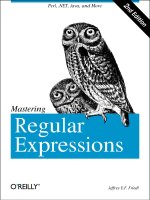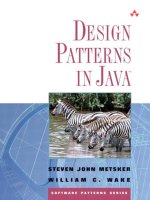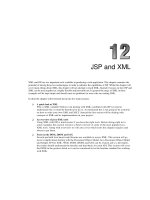Addison wesley design patterns in java 2nd edition apr 2006 ISBN 0321333020
Bạn đang xem bản rút gọn của tài liệu. Xem và tải ngay bản đầy đủ của tài liệu tại đây (4.68 MB, 478 trang )
DESIGN PATTERNS IN JAVA™
The Software Patterns Series
Series Editor: John M. Vlissides
The Software Patterns Series (SPS) comprises pattern literature of lasting significance to
software developers. Software patterns document general solutions to recurring problems
in all software-related spheres, from the technology itself, to the organizations that develop
and distribute it, to the people who use it. Books in the series distill experience from one
or more of these areas into a form that software professionals can apply immediately.
Relevance and impact are the tenets of the SPS. Relevance means each book presents patterns
that solve real problems. Patterns worthy of the name are intrinsically relevant; they are
borne of practitioners’ experiences, not theory or speculation. Patterns have impact when
they change how people work for the better. A book becomes a part of the series not just
because it embraces these tenets, but because it has demonstrated it fulfills them for its
audience.
Titles in the series:
Data Access Patterns: Database Interactions in Object-Oriented Applications; Clifton Nock
Design Patterns Explained, Second Edition: A New Perspective on Object-Oriented Design; Alan Shalloway
and James Trott
Design Patterns in C#; Steven John Metsker
Design Patterns in Java™; Steven John Metsker and William C. Wake
Design Patterns Java™ Workbook; Steven John Metsker
.NET Patterns: Architecture, Design, and Process; Christian Thilmany
Pattern Hatching: Design Patterns Applied; John M. Vlissides
Pattern Languages of Program Design; James O. Coplien and Douglas C. Schmidt
Pattern Languages of Program Design 2; John M. Vlissides, James O. Coplien, and Norman L. Kerth
Pattern Languages of Program Design 3; Robert C. Martin, Dirk Riehle, and Frank Buschmann
Pattern Languages of Program Design 5; Dragos Manolescu, Markus Voelter, and James Noble
Patterns for Parallel Programming; Timothy G. Mattson, Beverly A. Sanders, and Berna L. Massingill
Software Configuration Management Patterns: Effective Teamwork, Practical Integration; Stephen P. Berczuk
and Brad Appleton
The Design Patterns Smalltalk Companion; Sherman Alpert, Kyle Brown, and Bobby Woolf
Use Cases: Patterns and Blueprints; Gunnar Övergaard and Karin Palmkvist
For more information, check out the series web site at www.awprofessional.com/series/swpatterns
DESIGN PATTERNS
IN JAVA™
Steven John Metsker
William C. Wake
Upper Saddle River, NJ • Boston • Indianapolis • San Francisco
New York • Toronto • Montreal • London • Munich • Paris • Madrid
Capetown • Sydney • Tokyo • Singapore • Mexico City
Many of the designations used by manufacturers and sellers to distinguish their products are
claimed as trademarks. Where those designations appear in this book, and the publisher was
aware of a trademark claim, the designations have been printed with initial capital letters or in
all capitals.
The authors and publisher have taken care in the preparation of this book, but make no
expressed or implied warranty of any kind and assume no responsibility for errors or omissions.
No liability is assumed for incidental or consequential damages in connection with or arising
out of the use of the information or programs contained herein.
The publisher offers excellent discounts on this book when ordered in quantity for bulk purchases or special sales, which may include electronic versions and/or custom covers and content particular to your business, training goals, marketing focus, and branding interests. For
more information, please contact:
U.S. Corporate and Government Sales
(800) 382-3419
For sales outside the United States, please contact:
International Sales
Visit us on the Web: www.awprofessional.com
Library of Congress Cataloging-in-Publication Data
Metsker, Steven John.
Design patterns in Java / Steven John Metsker, William C. Wake.
p. cm.
Includes bibliographical references and index.
ISBN 0-321-33302-0 (hardback : alk. paper)
1. Java (Computer program language) 2. Software patterns. I. Wake, William C., 1960–
II. Title.
QA76.73.J38M482 2006
005.13'3—dc22
2006003471
Copyright © 2006 Pearson Education, Inc.
All rights reserved. Printed in the United States of America. This publication is protected by copyright, and permission must be obtained from the publisher prior to any prohibited reproduction,
storage in a retrieval system, or transmission in any form or by any means, electronic, mechanical, photocopying, recording, or likewise. For information regarding permissions, write to:
Pearson Education, Inc.
Rights and Contracts Department
75 Arlington Street, Suite 300
Boston, MA 02116
Fax: (617) 848-7047
ISBN 0-321-33302-0
Text printed in the United States on recycled paper at Courier Westford in Westford, Massachusetts.
3rd
Printing
August 2008
To Alison, Emma-Kate, and Sarah-Jane
—Steve
To May Lyn, Tyler, and Fiona
—Bill
This page intentionally left blank
CONTENTS
Preface
CHAPTER 1
PART I
CHAPTER 2
CHAPTER 3
CHAPTER 4
xiii
INTRODUCTION
1
Why Patterns?
Why Design Patterns?
Why Java?
UML
Challenges
The Organization of This Book
Welcome to Oozinoz!
Summary
1
2
3
4
4
5
6
7
INTERFACE PATTERNS
9
INTRODUCING INTERFACES
11
Interfaces and Abstract Classes
Interfaces and Obligations
Summary
Beyond Ordinary Interfaces
11
13
15
16
ADAPTER
17
Adapting to an Interface
Class and Object Adapters
Adapting Data for a JTable
Identifying Adapters
Summary
17
21
25
30
31
FACADE
33
Facades, Utilities, and Demos
Refactoring to FACADE
Summary
33
35
46
vii
viii
Contents
CHAPTER 5
CHAPTER 6
PART II
COMPOSITE
47
An Ordinary Composite
Recursive Behavior in Composites
Composites, Trees, and Cycles
Composites with Cycles
Consequences of Cycles
Summary
47
48
50
56
60
60
BRIDGE
63
An Ordinary Abstraction: On the Way to BRIDGE
From Abstraction to BRIDGE
Drivers as BRIDGEs
Database Drivers
Summary
63
66
68
69
71
RESPONSIBILITY PATTERNS
73
INTRODUCING RESPONSIBILITY
75
Ordinary Responsibility
Controlling Responsibility with Visibility
Summary
Beyond Ordinary Responsibility
75
77
79
79
SINGLETON
81
SINGLETON Mechanics
Singletons and Threads
Recognizing SINGLETON
Summary
81
83
84
86
OBSERVER
87
CHAPTER 7
CHAPTER 8
CHAPTER 9
CHAPTER 10
A Classic Example: OBSERVER in GUIs
Model/View/Controller
Maintaining an Observable Object
Summary
87
92
99
101
MEDIATOR
103
A Classic Example: GUI Mediators
Mediators of Relational Integrity
Summary
103
108
116
Contents
CHAPTER 11
CHAPTER 12
CHAPTER 13
PART III
CHAPTER 14
CHAPTER 15
CHAPTER 16
ix
PROXY
117
A Classic Example: Image Proxies
Image Proxies Reconsidered
Remote Proxies
Dynamic Proxies
Summary
117
122
125
131
136
CHAIN
137
OF
RESPONSIBILITY
An Ordinary Chain of Responsibility
Refactoring to CHAIN OF RESPONSIBILITY
Anchoring a Chain
CHAIN OF RESPONSIBILITY without COMPOSITE
Summary
137
139
142
144
144
FLYWEIGHT
145
Immutability
Extracting the Immutable Part of a Flyweight
Sharing Flyweights
Summary
145
146
148
152
CONSTRUCTION PATTERNS
153
INTRODUCING CONSTRUCTION
155
A Few Construction Challenges
Summary
Beyond Ordinary Construction
155
157
157
BUILDER
159
An Ordinary Builder
Building under Constraints
A Forgiving Builder
Summary
159
162
164
165
FACTORY METHOD
167
A Classic Example: Iterators
Recognizing FACTORY METHOD
Taking Control of Which Class to Instantiate
FACTORY METHOD in Parallel Hierarchies
Summary
167
168
169
171
173
x
CHAPTER 17
CHAPTER 18
CHAPTER 19
PART IV
CHAPTER 20
CHAPTER 21
CHAPTER 22
Contents
ABSTRACT FACTORY
175
A Classic Example: GUI Kits
Abstract Factories and Factory Method
Packages and Abstract Factories
Summary
175
180
184
185
PROTOTYPE
187
Prototypes as Factories
Prototyping with Clones
Summary
187
189
192
MEMENTO
193
A Classic Example: Using Memento for Undo
Memento Durability
Persisting Mementos Across Sessions
Summary
193
201
201
205
OPERATION PATTERNS
207
INTRODUCING OPERATIONS
209
Operations and Methods
Signatures
Exceptions
Algorithms and Polymorphism
Summary
Beyond Ordinary Operations
209
211
212
213
214
215
TEMPLATE METHOD
217
A Classic Example: Sorting
Completing an Algorithm
TEMPLATE METHOD Hooks
Refactoring to TEMPLATE METHOD
Summary
217
221
224
225
228
STATE
229
Modeling States
Refactoring to STATE
Making States Constant
Summary
229
233
238
240
Contents
xi
CHAPTER 23
CHAPTER 24
CHAPTER 25
PART V
STRATEGY
241
Modeling Strategies
Refactoring to STRATEGY
Comparing STRATEGY and STATE
Comparing STRATEGY and TEMPLATE Method
Summary
241
244
248
249
250
COMMAND
251
A Classic Example: Menu Commands
Using COMMAND to Supply a Service
COMMAND Hooks
COMMAND in Relation to Other Patterns
Summary
251
254
255
257
259
INTERPRETER
261
An INTERPRETER Example
Interpreters, Languages, and Parsers
Summary
261
274
275
EXTENSION PATTERNS
CHAPTER 26
CHAPTER 27
CHAPTER 28
277
INTRODUCING EXTENSIONS
279
Principles of Object-Oriented Design
The Liskov Substitution Principle
The Law of Demeter
Removing Code Smells
Beyond Ordinary Extensions
Summary
279
280
281
283
283
285
DECORATOR
287
A Classic Example: Streams and Writers
Function Wrappers
DECORATOR in Relation to Other Patterns
Summary
287
295
303
303
ITERATOR
305
Ordinary Iteration
Thread-Safe Iteration
Iterating over a Composite
Summary
305
307
313
324
xii
Contents
CHAPTER 29
PART VI
VISITOR
325
VISITOR Mechanics
An Ordinary VISITOR
VISITOR Cycles
VISITOR Risks
Summary
325
327
333
338
340
APPENDIXES
341
DIRECTIONS
343
Get the Most from This Book
Understand the Classics
Weave Patterns into Your Code
Keep Learning
343
344
344
345
APPENDIX B
SOLUTIONS
347
APPENDIX C
OOZINOZ SOURCE
427
Acquiring and Using the Source
Building the Oozinoz Code
Testing the Code with JUnit
Finding Files Yourself
Summary
427
427
428
428
429
UML
431
APPENDIX A
APPENDIX D
AT A
GLANCE
Classes
Class Relationships
Interfaces
Objects
States
432
433
435
436
437
Glossary
439
Bibliography
447
Index
449
PREFACE
DESIGN PATTERNS ARE class- and method-level solutions to common
problems in object-oriented design. If you’re an intermediate-level
Java programmer who wants to become advanced or an advancedlevel Java programmer who hasn’t yet studied design patterns, this
book is for you.
Design Patterns in Java™ takes a workbook approach. Each chapter
focuses on a particular pattern. In addition to explaining the pattern,
the chapter includes a number of challenges, each asking you to
explain something or to develop code that solves a problem.
We strongly urge you to stop and work through the challenges rather
than try to read this book straight through. You’ll learn more by putting in the work to do the challenges, even if it’s only a chapter or
two a week.
An Update
This book merges and updates two previous books: Design Patterns
Java Workbook™ and Design Patterns in C#. This book combines the
Java orientation of the former with the more stand-alone approach of
the latter. If you’ve already worked through the previous books, you
won’t need this one.
Coding Conventions
The code for this book is available online. See Appendix C: Oozinoz
Source on page 427 for details on how to obtain it.
We’ve used a style generally consistent with Sun’s coding conventions. Braces are omitted where possible. We have had to make a couple of compromises to fit the book format. To fit the narrow columns,
xiii
xiv
Preface
variable names are sometimes shorter than we’d really use. And to
avoid the complications of source control, we name multiple versions
of a file with a digit appended to the name (e.g., ShowBallistics2).
In real life, you’d use source control and work only with the latest
version of a class.
Acknowledgments
A book is a challenging undertaking. Along the way, a number of
reviewers have provided us with valuable advice: Daryl Richter, Adewale Oshineye, Steven M. Luplow, Tom Kubit, Rex Jaeschke, Jim Fox,
and David E. DeLano. Each one made suggestions that improved the
end result. Readers and reviewers of the earlier books have contributed as well.
Thanks also to the editorial staff at Addison-Wesley, especially Chris
Guzikowski, Jessica D’Amico, and Tyrrell Albaugh. Other editors
helped along the way, including Mary O’Brien and John Wait.
We’d like to thank the late John Vlissides for his encouragement and
advice on this and other books. John was the editor of the Software
Patterns Series, coauthor of the original Design Patterns book, a friend,
and an inspiration.
In addition to relying heavily on Design Patterns, we have benefited
from many other books: See the Bibliography on page 447. In particular, The Unified Modeling Language User Guide [Booch, Rambaugh, and
Jacobsen 1999] provided clear explanations of UML, and Java™ in a
Nutshell [Flanagan 2005] provided concise and accurate help on Java
topics. The Chemistry of Fireworks [Russell 2000] has been the source
for information on realistic fireworks examples.
Finally, we’re grateful to everyone on the production staff for their
hard work and dedication. They’re the ones who turn the bytes into
printed words.
Steve Metsker ()
Bill Wake ()
1
INTRODUCTION
THIS BOOK COVERS the same set of techniques as the classic book
Design Patterns, written by Erich Gamma, Richard Helm, Ralph
Johnson, and John Vlissides [Gamma et al. 1995] and provides examples in a Java setting. This book also includes many “challenges”—
exercises designed to help you strengthen your ability to apply design
patterns in your own programs.
This book is for developers who know Java and who want to
improve their skills as designers.
Why Patterns?
A pattern is a way of doing something: a way of pursuing an intent, a
technique. The idea of capturing effective techniques applies to many
endeavors: making food, fireworks, software, and other crafts. In any
new craft that is starting to mature, the people working on it will
begin to find common, effective methods for achieving their aims
and solving problems in various contexts. The community of people
who practice a craft usually invent jargon that helps them talk about
their craft. Some of this jargon will refer to patterns, or established
techniques for achieving certain aims. As a craft and its jargon grows,
writers begin to play an important role. Writers document a craft’s
patterns, helping to standardize the jargon and to publicize effective
techniques.
Christopher Alexander was one of the first writers to encapsulate a
craft’s best practices by documenting its patterns. His work relates to
architecture—of buildings, not software. In A Pattern Language: Towns,
Buildings Construction (Alexander, Ishikouwa, and Silverstein 1977),
Alexander provides patterns for architecting successful buildings and
towns. His writing is powerful and has influenced the software community, partially because of the way he looks at intent.
1
2
Chapter 1 • Introduction
You might think that the intent of architectural patterns would be
something like “to design buildings.” But Alexander makes it clear
that the intent of architectural patterns is to serve and inspire the
people who will occupy buildings and towns. Alexander’s work
showed that patterns are an excellent way to capture and convey the
wisdom of a craft. He also established that properly perceiving and
documenting the intent of a craft is a critical, philosophical, and elusive challenge.
The software community has resonated with the patterns approach
and has created many books that document patterns of software
development. These books record best practices for software process,
software analysis, high-level architecture, and class-level design. New
pattern books appear every year. If you are choosing a book to read
about patterns, you should spend some time reading reviews of available books and try to select the book that will help you the most.
Why Design Patterns?
A design pattern is a pattern—a way to pursue an intent—that uses
classes and their methods in an object-oriented language. Developers
often start thinking about design after learning a programming language and writing code for a while. You might notice that someone
else’s code seems simpler and works better than yours does, and you
might wonder how that developer achieves such simplicity. Design
patterns are a level up from code and typically show how to achieve a
goal using a few classes. A pattern represents an idea, not a particular
implementation.
Other people have discovered how to program effectively in objectoriented languages. If you want to become a powerful Java programmer, you should study design patterns, especially those in this book—
the same patterns that Design Patterns explains.
Design Patterns describes 23 design patterns. Many other books on
design patterns have followed, so there are at least 100 design patterns worth knowing. The 23 design patterns that Gamma, Helm,
Johnson, and Vlissides placed in Design Patterns are probably not
absolutely the most useful 23 design patterns to know. On the other
hand, these patterns are near the top of the list. The authors of Design
Why Java?
3
Patterns chose well, and the patterns they document are certainly
worth learning. These patterns can serve as a foundation as you
branch out and begin learning patterns from other sources.
GoF
You may have noted the potential confusion between “design patterns” the
topic and Design Patterns the book. Because the topic and the book title sound
alike, many speakers and some writers distinguish them by referring to the book
as the “Gang of Four,” or the “GoF,” book, referring to the number of its
authors. In print, it is not so confusing that Design Patterns refers to the book
and “design patterns” refers to the topic. Accordingly, this book avoids using
the term “GoF.”
Why Java?
This book gives its examples in Java, the object-oriented (OO) language developed at Sun. Java, its libraries, and associated tools form a
suite of products for developing and managing systems with multitiered, object-oriented architectures.
One reason Java is important is that it is a consolidation language,
designed to absorb the strengths of earlier languages. This consolidation has fueled the popularity of Java and helps ensure that future
languages may well evolve from this language rather than depart radically from it. Your investment in Java will almost surely yield value
in any language that supplants Java.
The patterns in Design Patterns apply to Java because, like Smalltalk,
C++, and C#, Java follows a class/instance paradigm. Java is much
more similar to Smalltalk and C++ than it is to, say, Prolog or Self.
Although competing paradigms are important, the class/instance
paradigm is a practical step forward in applied computing. This book
uses Java because of its popularity and because Java appears to lie
along the evolutionary path of languages that we will use for years
to come.
4
Chapter 1 • Introduction
UML
Where this book’s challenges (exercises) have solutions in code, this
book uses Java. But many of the challenges ask you to draw a diagram
of how classes, packages, and other elements relate. You can use any
notation you like, but this book uses Unified Modeling Language
(UML) notation. Even if you are familiar with UML, it is a good idea
to have a reference handy. Two good choices are The Unified Modeling
Language User Guide [Booch, Rumbaugh, and Jacobsen 1999], and
UML Distilled [Fowler with Scott 2003]. The bare minimum of UML
knowledge that you need for this book is provided in “Appendix D:
UML at a Glance” on page 431.
Challenges
No matter how much you read about doing something, you won’t
feel as though you know it until you do it. This is true partially
because until you exercise the knowledge you gain from a book, you
won’t encounter subtleties, and you won’t grapple with alternative
approaches. You won’t feel confident about design patterns until you
apply them to some real challenges.
The problem with learning through experience is that you can do
damage as you learn. You can’t apply patterns in production code
before you are confident in your own skills. But you need to start
applying patterns to gain confidence. What a conundrum! The solution is to practice on example problems, where mistakes are valuable
but painless.
Each chapter in this book begins with a short introduction and then
sets up a series of challenges for you to solve. After you come up
with a solution, you can compare your solution with one given in
Solutions, page 347. The solution in the book may take a different
slant from your solution or may provide you with some other
insight.
You probably can’t go overboard in how hard you work to come up
with answers to the challenges in this book. If you consult other
books, work with a colleague, and write sample code to check out
your solution, terrific! You will not regret investing your time and
energy in learning how to apply design patterns.
The Organization of This Book
5
A danger lurks in the solutions that this book provides. If you flip to
the solution immediately after reading a challenge, you will not gain
much from this book. The solutions in this book won’t do you any
good if you don’t first create your own solutions.
The Organization of This Book
There are many ways to organize and categorize patterns. You might
organize them according to similarities in structure, or you might follow the order in Design Patterns. But the most important aspect of any
pattern is its intent, that is, the potential value of applying the pattern. This book organizes the 23 patterns of Design Patterns according
to their intent.
Having decided to organize patterns by intent raises the question of
how to categorize intent. This book adopts the notion that the intent
of a design pattern is usually easily expressed as the need to go
beyond the ordinary facilities that are built into Java. For example,
Java has plentiful support for defining the interfaces that a class
implements. But if you have a class with the “wrong” interface and
need to somehow make it meet the needs of a client, you may decide
to apply the ADAPTER pattern. The intent of the ADAPTER pattern is to
help you go beyond the interface facilities built into Java.
This book places design pattern intent in five categories, as follows:
1. Interfaces
2. Responsibility
3. Construction
4. Operations
5. Extensions
These five categories account for the five parts of this book. Each part
begins with a chapter that discusses and presents challenges related to
features built into Java. For example, Part I begins with a chapter on
ordinary Java interfaces. This chapter will challenge your understanding of the Java interface construct, especially in comparison to
abstract classes. The remaining chapters of Part I address patterns
whose primary intent involves the definition of an interface, the set
of methods that a client can call from a service provider. Each of these
6
Chapter 1 • Introduction
patterns addresses a need that cannot be addressed solely with Java
interfaces.
Categorizing patterns by intent does not result in each pattern supporting only one type of intent. When it supports more than one
type of intent, a pattern appears as a full chapter in the first part to
which it applies and gets a brief mention in subsequent parts.
Table 1.1 shows the categorization behind the organization of this
book.
TABLE 1.1 A Categorization of Patterns by Intent
Intent
Patterns
Interfaces
ADAPTER, FACADE, COMPOSITE, BRIDGE
Responsibility
SINGLETON, OBSERVER, MEDIATOR, PROXY, CHAIN OF
RESPONSIBILITY, FLYWEIGHT
Construction
BUILDER, FACTORY METHOD, ABSTRACT FACTORY,
PROTOTYPE, MEMENTO
Operations
TEMPLATE METHOD, STATE, STRATEGY, COMMAND,
INTERPRETER
Extensions
DECORATOR, ITERATOR, VISITOR
We hope that you will question the categorization in Table 1.1. Do
you agree that SINGLETON is about responsibility, not construction? Is
COMPOSITE an interface pattern? Categorizing patterns is subjective.
But we hope that you will agree that thinking about the intent
behind patterns and thinking about how you will apply patterns are
very useful exercises.
Welcome to Oozinoz!
The challenges in this book all cite examples from Oozinoz Fireworks, a fictional company that manufactures and sells fireworks and
puts on fireworks displays. (Oozinoz takes its name from the sounds
heard at Oozinoz exhibitions.) You can acquire the code from
Summary
7
www.oozinoz.com. For more information about building and testing
the source code, see Appendix C: Oozinoz Source, page 427.
Summary
Patterns are distillations of accumulated wisdom that provide a standard jargon, naming the concepts that experienced practitioners
apply. The patterns in the classic book Design Patterns are among the
most useful class-level patterns and are certainly worth learning. This
book explains the same patterns as those documented in Design Patterns but uses Java and its libraries for its examples and challenges. By
working through the challenges in this book, you will learn to recognize and apply an important part of the accumulated wisdom of the
software community.
This page intentionally left blank
PART I
INTERFACE
PATTERNS
This page intentionally left blank









